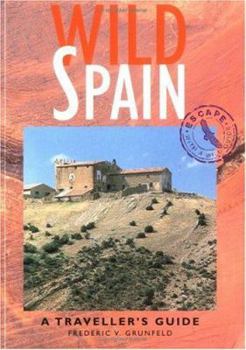Wild Spain: A Traveller's Guide
Select Format
Select Condition 
Book Overview
An unrivalled series of illustrated guide-books to the wild places far from home and work, the long walks, mountain hide-aways, woods, moors, sea coasts and remote islands where travellers can still... This description may be from another edition of this product.
Format:Paperback
Language:English
ISBN:1566563224
ISBN13:9781566563222
Release Date:January 1999
Publisher:Interlink Books
Length:224 Pages
Weight:0.95 lbs.
Dimensions:0.5" x 5.9" x 8.2"
Customer Reviews
1 rating
Planning to Party?
Published by Thriftbooks.com User , 16 years ago
Sorry, my friend. This is not a guide to the wild side of post-Franco Spain. You'll find that easily enough just by staying on the streets of Salamanca or Seville past midnight. For Spanish university students, the weekend begins on Thursday. Despite 2500 years of severe ecological degradation, Spain retains some areas of almost pristine emptiness, chiefly in the mountains. I hesitate to apply the term wilderness to anything in Spain, since everywhere has been impacted by humanity, and only places useless to mankind have remained "wild." In Spain, desolation offers isolation. Nowhere in the world is the impact of human overexploitation of resources so obvious as in Spain. The Romans treated Spain as short-sightedly as the Americans are treating California. West of Leon, for example, there's an area of "beautiful" red-rock hoodoos reminiscent of the American Southwest; the erosion, however, is not natural but rather the result of hydraulic gold mining by the Romans 2000 years ago. The landscape hasn't yet begun to heal. Most of Spain was forested when the Romans arrived. It was said that a squirrel could caper from Lisbon to Barcelona through the trees without ever touching the ground. Today Spain is chiefly arid and treeless. Spain is visible proof that mankind CAN impact climate and ecology both profoundly and permanently. Neverthless, there are places in Spain that will delight "walkers, amateur naturalists, lovers of the wild, and travelers of all kinds," as the author of Wild Spain declares. The book offers well-written descriptions of dozens of such beauty spots, along with convincing photos and suggestive maps. Notes about the animal species that have survived man's onslaught are interesting, though one's likelihood of seeing an ibex is close to minus 10. Birds are a better story. Spain is the natural corridor for birds migrating from Europe to Africa; storks are common, flamingos and spoonbills are regular visitors, hoopoes hop from housetop to housetop. A visit to a Spanish market in the winter will surprise most Americans with the variety of wild game for sale - hares, boar, deer, partridges and grouse and other birds. This wild game doesn't come to market from the "wild" corners of the peninsula. Most of it comes from the "dehesa" - the seemingly uncultivated acres and acres of cork trees, curiously spaced apart. The "dehesa" is a human artifact, and a stunning example of sustainable agriculture; the cork oaks provide acorn fodder for the semi-wild swine that will eventually become serrano ham, as well as environment for smaller animals and birds that are hunted for sale in the markets. The cork is of course a valuable product also, but an endangered one. As synthetic corks and screw-tops snatch a share of the wine bottle business, the economic viability of the "dehesa" becomes threatened. Think of that next time you buy wine! Readers should be warned that hiking trails are often hard to find and even harder to follow in Spain, with




